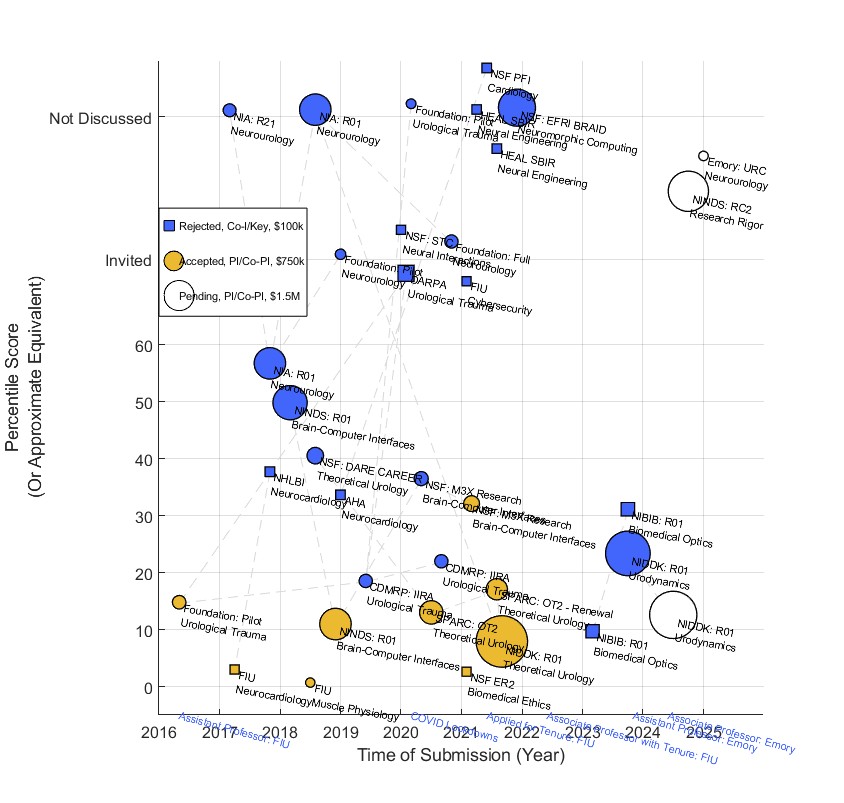I lurk on science social media (X and BlueSky) and the types of posts about metascience I typically see come in either the triumph flavor (e.g., I just published this thing! or My new grant is here! or I am thankful for this new award!) or the catastrophe flavor (e.g., This is why I’m leaving academia. or The brutality of the funding landscape is annihilating work-life balance.). I don’t think this setup is bad, necessarily, and people should be allowed to post about these things (and I enjoy reading them – I’m still on the SM platforms, after all). But I do think an unintended consequence is that it can be hard to get a sense of what the pace of professional research science is like from SM feeds (or what normal life is like in general). This is especially true for new PIs who don’t have a good baseline for what to expect.
Knowing full well that I am N=1 (and all the generalizability caveats that entails), I nevertheless offer up a record of every one of my grant submissions since starting as an assistant professor in 2016. I hope this plot conveys a fuller picture of what a professional life on the funding cycle looks like and what the first part of a career looks like in a research intensive university. (I would post paper submission histories as well – if only I had been tracking the data.)

Chart Details: The entries appear on the horizontal axis according to the submission month of the grant. Entries appear on the vertical axis according to the NIH-equivalent score given to them by the review process at the granting agency. (To plot everything on the same vertical axis, I “converted” non-NIH submissions into the NIH scale using plenty of fudging. For example, I normalized the qualitative categorical NSF ratings of each reviewer to the NIH scale and averaged, and used similarly non-validated methods for the other granting agencies.) When agencies do not give scores, but instead use the two round invite-then-decide method, entries are plotted at the “invited” position. I used some randomized vertical jitter to help visually separate some of the entries (since their locations are not especially precise anyway). Grants that have yet to be scored are placed, arbitrarily, between “invited” and “not discussed“. Shape indicates my role in the submission, square for supporting and circle for lead or co-PI. Color indicates the funding status of the grant, blue for rejected, orange for funded, white for pending a decision. Size indicates the amount ($) requested for the entire award (if I am PI) or just the sub-portion under my control (if I am a co-I). The area of each entry scales with amount, with examples given in the legend. Annotations list the institute and mechanism (line 1) and the general topic (line 2). Connecting lines in light gray show which prior submissions directly influenced which subsequent submissions, in terms of research ideas, text, preliminary data, etc. I connect them if they have something like at least 20% common material or ideas. Dates start in summer 2016 when I took my 1st assistant professor job at FIU (so it does not show grants submitted during my PhD or postdoc) and continues to the present moment.
Reflections and Context
I have been lucky with my grant submissions and reviewers have been sympathetic to my ideas. That said, the first thread of experiments we started in the lab (age-related bladder dysfunction due to afferents and reflexes) have still never been funded directly by any agency, despite my feeling that it is an important question and a good research direction. And at least someone else agrees with me – I’ve presented on the material as a keynote speaker before. I guess this paragraph is best summarized by Joe Walsh: I can’t complain, but sometimes I still do.
For context, I started at Florida International University, an R1 that places a big emphasis on faculty funding their work with external grant money (stated without judgment). I moved to Emory University at the end of 2023 (in Rehab Med and BME), another R1, and the School of Medicine places even more emphasis on research funding. Whether or not so much attention should be dedicated to faculty securing funding is a topic for another post. But I would at least note that, being in the biomedical field, even without the university pressure I would need to secure funding to run the experiments I think are important and pay personnel to help me run them. (Who am I kidding? My lab members run all the experiments without me.)
Anecdotally, I have had the greatest success when smart and trusted colleagues have been willing to review my proposals and/or discuss the content of the ideas I proposed.
I hope this is useful for someone, and good luck out there.
